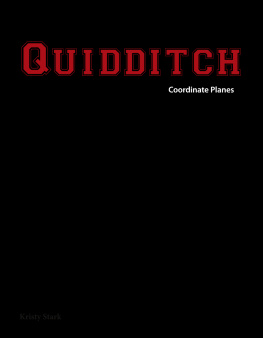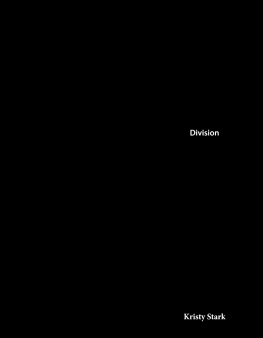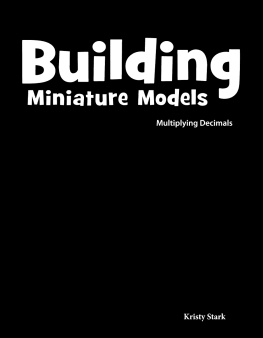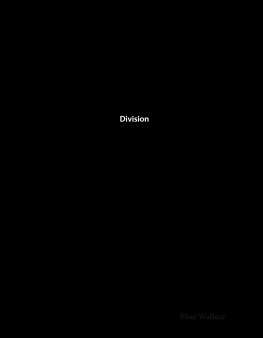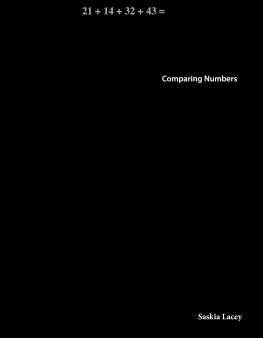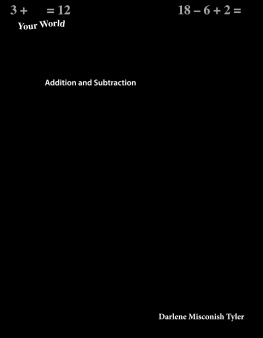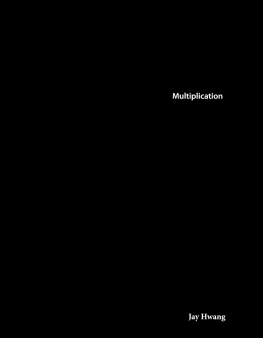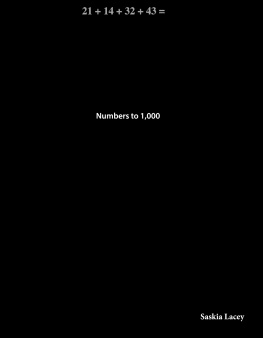Kristy Stark - Spectacular Sports: Quidditch: Coordinate Planes
Here you can read online Kristy Stark - Spectacular Sports: Quidditch: Coordinate Planes full text of the book (entire story) in english for free. Download pdf and epub, get meaning, cover and reviews about this ebook. year: 2018, publisher: Teacher Created Materials, genre: Home and family. Description of the work, (preface) as well as reviews are available. Best literature library LitArk.com created for fans of good reading and offers a wide selection of genres:
Romance novel
Science fiction
Adventure
Detective
Science
History
Home and family
Prose
Art
Politics
Computer
Non-fiction
Religion
Business
Children
Humor
Choose a favorite category and find really read worthwhile books. Enjoy immersion in the world of imagination, feel the emotions of the characters or learn something new for yourself, make an fascinating discovery.
- Book:Spectacular Sports: Quidditch: Coordinate Planes
- Author:
- Publisher:Teacher Created Materials
- Genre:
- Year:2018
- Rating:3 / 5
- Favourites:Add to favourites
- Your mark:
- 60
- 1
- 2
- 3
- 4
- 5
Spectacular Sports: Quidditch: Coordinate Planes: summary, description and annotation
We offer to read an annotation, description, summary or preface (depends on what the author of the book "Spectacular Sports: Quidditch: Coordinate Planes" wrote himself). If you haven't found the necessary information about the book — write in the comments, we will try to find it.
Spectacular Sports: Quidditch: Coordinate Planes — read online for free the complete book (whole text) full work
Below is the text of the book, divided by pages. System saving the place of the last page read, allows you to conveniently read the book "Spectacular Sports: Quidditch: Coordinate Planes" online for free, without having to search again every time where you left off. Put a bookmark, and you can go to the page where you finished reading at any time.
Font size:
Interval:
Bookmark:
0covercover.xhtmlSpectacular Sports Quidditch Coordinate Planes Kristy Starkcover1page0001page0001.xhtml22page0002page0002.xhtml33page0003page0003.xhtml44page0004page0004.xhtmlTable of Contents From Fantasy to Reality 4 How to Play 10 The Rise of Quidditch 20 Ways to Get Involved 24 Problem Solving 28 Glossary 30 Index 31 Answer Key 3255page0005page0005.xhtmlFrom Fantasy to Reality If you have ever read one of J. K. Rowling's Harry Potter books or watched one of the movies, you have probably heard of Quidditch. Rowling's Quidditch involves Harry and his friends throwing balls, called quaffles, through an opposing team's goals. It is a game involving athletic skill. Of course, Rowling spiced up the sport with a little magic; athletes compete from the perch of their flying broomsticks! Many nonwizards (or Muggles, as they are called in the books) have dreamed of soaring through the sky as they play Quidditch with their friends. Of course, they can't fly in the real world. But, this detail did not stop some aspiring Quidditch players from bringing this game down to earth. They created their own version based on the game from the famous stories. Now, Quidditch is a real sport that anyone can play. And, you don't even need a flying broomstick or magical powers to compete! A store display features a Quidditch board game along with other related merchandise.66page0006page0006.xhtmlA player scores during tryouts for a Quidditch team in Toronto, Canada. This book describes the magical game of Quidditch.77page0007page0007.xhtmlCollege student Xander Manshel worked to make Quidditch a real sport for his friends. In 2005, Manshel was a student at Middlebury College in Vermont. He enjoyed playing sports with his friends on Sundays. But, they wanted to try something new. So, he and his friends decided to turn Quidditch into a real game. They played their first game in October 2005. Players brought brooms and tied towels to their backs to make capes. One player even brought a lamp to ride! They found that Quidditch was a very physical and enjoyable sport. More people wanted to play. After only one month, there were seven Quidditch teams at the school! The teams were able to play in a tournament against one another. By 2006, the game had gained popularity. Students at Middlebury told their friends at other schools about it. These people started to form their own teams, too. In December 2006, the Wall Street Journal published a story about the sport. It encouraged even more people to play. The Quidditch team from Middlebury College marches in a parade before playing in the sport's 2010 World Cup.88page0008page0008.xhtmlQuidditch competitors warm up before a World Cup match in New York. LET'S EXPLORE MATH Imagine that a Quidditch coach designs a game plan by plotting the team's goalkeeper on a coordinate plane, labeled as Point G. Which of the following is true about the goalkeeper's position? How do you know? A. The goalkeeper's position is a distance of 7 units from the y-axis and 5 units from the x-axis. B. The goalkeeper's position is a distance of 5 units from the y-axis and 7 units from the x-axis.99page0009page0009.xhtmlThe first Muggle World Cup match was played in 2007. Teams from Middlebury and Vassar colleges faced off. After the first successful World Cup match, more and more schools formed teams. By the next World Cup, 12 schools had joined the competition. There was also a team from McGill University in Canada. Quidditch was officially an international sport! Throughout the years, the number of schools playing Quidditch has grown. Colleges and high schools from around the world have joined the mix. The fifth World Cup in 2011 had almost a hundred teams. That's 50 times as many teams as five years before! More and more teams formed in new areas. As a result, there was a need to establish official rules for everyone to follow. A list of rules would help everyone play the game the same way. It would also help people understand how to play the new sport. Alex Benepe, the founder of the International Quidditch Association, awards the 2013 championship trophy to the University of Texas team.1010page0010page0010.xhtmlA Quidditch player gets ready to throw a ball over a fallen defender.1111page0011page0011.xhtmlHow to Play All sports have rules even sports inspired by fantasy. The rules describe everything, from the players to the field where the game takes place. Organizing a Quidditch Team A Quidditch team can be comprised of anywhere between 4 and 21 players. But, no more than 7 players can be on the field at any time. Those players play 4 different positions : 3 are chasers, 2 are beaters, 1 is a seeker, and 1 is a keeper. Each position is assigned a different colored headband. The headbands help players know each person's role. Members of the Unspeakable team practice during a Quidditch training session in London.1212page0012page0012.xhtmlNo Quidditch match would be complete without brooms! In real life, all players must hold brooms between their legs as they play and hold onto them at all times. Players think that the brooms make the game more challenging since you can only use one hand to catch and throw. Quidditch also has rules for ensuring that teams are coed. Each team may only have up to four players of the same gender. Having coed teams is important to the founders of Quidditch. They want it to be a game everyone can play together as equals on the field. This UCLA player's white headband identifies him as a chaser. The Keele Team poses before playing the first official Quidditch match in the United Kingdom in 2012.1313page0013page0013.xhtmlSetting Up the Pitch The official name of a Quidditch field is a pitch. A rectangle makes up the central area of the pitch. There are sidelines on the edges, and there are keeper zones on the ends. Behind the keeper zones are three goals. The goals are hoops attached to posts in the ground. The posts help the hoops stand upright so players can throw or kick balls through them. There are very strict rules about the dimensions of a Quidditch pitch. The main rectangle must be 36 yards (33 meters) wide and 24 yd. (22 m) long. There is a semicircle on each end of the rectangle, giving the pitch an oval shape. Each semicircle is 36 yd. (33 m) in diameter. The pitch is also divided into two halves by the midfield line. There is a mark at the midpoint, showing the exact center of the pitch. Different marks and lines on the pitch show players where to line up and where balls must be placed when they are put into play. LET'S EXPLORE MATH Imagine that goalposts are being installed on a pitch for a Quidditch match and that a coordinate plane is used to ensure the location is exact. The point shows the location of one of the goalposts. 1.Write the ordered pair that describes the location of the goalpost. 2.Another goalpost needs to be installed a distance of 9 units from the y-axis and 5 units from the x-axis. Write an ordered pair for the location of this goalpost.1414page0014page0014.xhtmlgoal hoops1515page0015page0015.xhtmlPlaying Positions When people play Quidditch, they play with different types of balls. A hallmark of Quidditch is that all of the balls are used in the game at the same time. However, players of each position use the balls in different ways. Chasers use balls called quaffles. For real-life Quidditch, a volleyball is used. Chasers use the quaffle to score goals by throwing or kicking it through one of the three hoops on the ends of the pitch. Chasers score 10 points for their team each time they are successful. The keeper from the opposing team has the responsibility of keeping the quaffle out of the hoops. A chaser throws a quaffle during a match in London.1616page0016page0016.xhtmlBeaters use a different type of ball. Their objective is to get players from the other team out of the game by throwing balls called bludgers. You may recognize these as dodgeballs. When hit, players must drop any ball they are holding, dismount from their brooms, return to their own goal area, and touch part of any post. Once this is done, players may re-enter the game. A beater runs down the pitch with a bludger. LET'S EXPLORE MATH Imagine that a chaser is planning a starting location using a coordinate plane. The three points show different possibilities. 1.The chaser decides to start at (4, 7). Which point represents the chaser's location? 2.If the chaser moves a distance of 1 unit closer to the y-axis, which point represents the player's new position? What ordered pair describes this point?1717page0017page0017.xhtmlThe last piece of gear used in Quidditch is the snitch. It is by far the most important piece of gear in the game. The game can only end once it is caught. The seeker who catches the snitch scores 30 points. Since it is worth so many points, catching the snitch can be the difference between victory and defeat for a team. Just like there are no flying broomsticks in the real-life game of Quidditch, there are no flying snitches. For this version of the game, the snitch is a tennis ball in a sock that has been attached to a specially designated player's waistband. That player is the snitch runner. Snitch runners do not play for either team. It is their job to avoid being captured for as long as possible. They run, dodge, dip, and dive to avoid capture. Once a team's seeker removes the snitch from the snitch runner's waistband, the game is over. golden snitch snitch runner1818page0018page0018.xhtmlLET'S EXPLORE MATH Laurel is playing a video game form of Quidditch. She is playing a seeker trying to capture the snitch. The positions of each are plotted on the coordinate plane. 1.What ordered pair represents the snitch's location? What ordered pair represents Laurel's location? 2.For this video game, Laurel can only capture the snitch by moving in straight-line segments. Write a set of directions that Laurel can use to move from her current position to the snitch's location. A seeker tries to capture the snitch during a match in London.1919page0019page0019.xhtmlCapturing the snitch requires great athletic ability. The snitch runner doesn't enter play until 17 minutes of action have taken place. The snitch runner also runs as fast as he or she can to avoid being captured. When Muggle Quidditch first began, snitch runners could hide anywhere they wanted. Some would scale buildings. Others would change clothes and hide among the crowd. Now, things are a little easier. The snitch runner must be dressed completely in yellow. Avoiding capture is challenging when wearing such a bright color! And, snitch runners are limited to the boundaries of the rectangles at the centers of pitches. But, within those rectangles they can go anywhere to evade capture. The seeker for each team has the same crucial job : capture the snitch. Capturing the snitch is worth the trouble. Remember, it not only ends the game, but also scores three times the points as a regular goal. So, seekers do not give up easily. But, speedy snitch runners make them work hard for the win! LET'S EXPLORE MATH Seekers are always looking for the snitch. Imagine that the snitch and a seeker are located at the points shown on the coordinate plane. 1.What ordered pair describes the snitch's location? 2.What ordered pair describes the seeker's location? 3.The seeker from the other team moves into position. Three players now form the points of a triangle. Name two different ordered pairs describing points where this new seeker might be located.2020page0020page0020.xhtmlA snitch runner defends himself against players during a match in Germany. The seeker from Bowling Green State University celebrates after his team advances to the semifinals in the 2013 World Cup.2121page0021page0021.xhtmlThe Rise of Quidditch Even though Quidditch requires hard work and lacks actual magic, it has still cast a spell on players. The sport continues to grow. Every day it becomes more and more popular. The number of players around the world is constantly rising. How did it evolve from one college campus to an international sensation? Official associations greatly helped with its growth. A chaser from the University of Texas attempts to score a goal during the 2013 championship match against UCLA.2222page0022page0022.xhtmlU.S. Quidditch (USQ) was founded in 2010. This group is in charge of making game rules used in the United States. The USQ hosts events to promote the game. It also teaches it to new players. The group strives to make Quidditch exciting for both players and spectators. It hopes that one day, everyone will know about the sport. The USQ wants more people to play it, too. It thinks Quidditch can help build communities and shape future leaders. The USQ hopes that when players and spectators get involved with Quidditch, they will get to know each other better. They will develop respect for one another. USQ logo patch Members of the University of Sydney Quidditch team pose for a photo during the opening ceremonies of the 2014 World Cup.2323page0023page0023.xhtmlMembers of the Keele and Radcliffe teams chase a quaffle during a match in London.2424page0024page0024.xhtmlThe International Quidditch Association (IQA) works to bring Quidditch to different countries around the world. It trains leaders and coaches. It represents hundreds of teams. It also helps to start teams in places where the game has not yet been played. One of the IQA's main goals is to keep the sport coed. Members of the group think this is crucial to the success of the sport. They believe it helps players develop respect for each other as athletes. As one IQA player put it, "I've always felt girls and boys should be on an equal playing field, and people have always disagreed with me. I've seen people change their minds on the issue just by watching a game, and it's great to hear people go from saying She's great, for a girl' to She's a great chaser. ' It makes a difference. " Quidditch is about exercise and having fun. But, it is about respect for others, too. The IQA remembers that in everything they do. Teams enter the opening ceremonies of the 2014 World Cup in South Carolina.2525page0025page0025.xhtmlWays to Get Involved Whether you are looking to get in touch with your inner wizard, trying to find a game that allows boys and girls to compete together, or just looking for a new sport to try, Quidditch may be right for you. There are several ways to get started. The USQ has some really helpful ideas for how people can start new Quidditch teams. It suggests that you start by asking your friends to try the sport. If everyone is new to the game, you can all learn how to play while being active and having a good time. Next, you need to gather the necessary equipment. The USQ offers grants to new teams that are trying to get started. But the equipment does not need to be new or expensive. Plastic pipes can stand in for brooms. Toy hoops make perfect goals. With a volleyball and a few dodgeballs, you can be on your way to the pitch! Quidditch equipment2626page0026page0026.xhtmlA player runs down the pitch during a match in California. A competitor sets up the goals for the Crumpet Cup Quidditch Tournament in London.2727page0027page0027.xhtmlDo you want to make Quidditch more popular? Create and distribute flyers to people at school to join teams. Or, start a team website. If learning more about Quidditch is the objective, check if nearby colleges or high schools have teams. Then, you can ask them to allow you to observe their practices. Perhaps one of those players would be willing to help your team. Fundraising efforts can support your Quidditch dreams. By raising money, you can purchase equipment and attend tournaments. Or, the money can be used to join Quidditch associations, which can help you get involved with the sport.2828page0028page0028.xhtmlNot ready to start your own team? Be a true seeker and don't give up! As the sport becomes more popular, more opportunities are available to people new to Quidditch. Maybe teams already exist in your area. Do some research to find out whether there are teams looking for new players. If you happen to find a flying broomstick, snatch it up and go capture that snitch. But, until then, magic is not necessary to play Quidditch! LET'S EXPLORE MATH Meg, Finn, Juan, and Clare made flyers to invite people to join their Quidditch team. They stand at different places in their school's courtyard to hand out the flyers. The coordinate plane of the courtyard shows their positions. 1.Imagine that the points are connected in order M, F, J, C, M. What geometric figure is formed? How do you know? 2.Name two sets of line segments that are parallel. 3.Name two sets of line segments that are perpendicular.2929page0029page0029.xhtmlProblem Solving Katelyn, Toms, Josh, and Maria are practicing Quidditch. So they can easily run routes and give each other directions, their practice pitch is set up like a coordinate plane. Points A, B, C, and D show their current locations on the pitch. Answer the questions to find out more about their practice. 1.Write the ordered pairs that describe the points on the coordinate plane. 2.Use the following clues to match the players with the position points. a.Katelyn is a chaser. She is less than 10 units from the y-axis and less than 3 units from the x-axis. b.Toms is another chaser. He is more than 2 units from the y-axis and less than 5 units from the x-axis. c.Josh is a seeker. He is more than 8 units from the x-axis. d.Maria is a beater. She is less than 6 units from the x-axis. 3.During practice, players run sprints. Katelyn runs in a line segment that starts at (4, 2) and ends at (4, 8). a.Toms wants to run parallel to Katelyn's route. What ordered pairs represent starting and stopping points he can use? b.Josh wants to run parallel to the routes of Katelyn and Toms. What ordered pairs represent starting and stopping points he can use? c.Maria wants to run perpendicular to Katelyn's route. What ordered pairs represent starting and stopping points she can use?3030page0030page0030.xhtml3131page0031page0031.xhtmlGlossary aspiring seeking to accomplish a particular goal associations organized groups of people who share common interests boundaries lines that show where one area ends and another area begins coed including both males and females comprised made up of something crucial very important designated chosen for a particular job or task diameter the distance across a circle passing through a center point dismount to get down from something evade to avoid or stay away from evolve to develop into a better or more advanced state founders people who have created groups or companies grants money given to people for a specific purpose hallmark quality that is specific to a particular person or thing international having to do with two or more countries Muggles fantasy term used to refer to people without magic in their blood objective goal or purpose official accepted and approved physical involving activity with one's body published printed in a book, magazine, newspaper, or other form of written communication available to the public tournament a competition that involves many teams3232page0032page0032.xhtmlIndex beaters Benepe, Alex bludger broomsticks chaser coed coordinate plane International Quidditch Association (IQA) keeper Manshel, Xander McGill University Middlebury College pitch Potter, Harry quaffles Rowling, J. K. seeker snitch snitch runner U.S. Quidditch (USQ) Vassar College Wall Street Journal World Cup3333page0033page0033.xhtmlAnswer Key Let's Explore Math page 7 : B; Point G (5, 7) is a distance of 5 units from the y-axis and 7 units from the x-axis. page 12 : 1.(9, 1) 2.( 9, 5) page 15 : 1.Point C 2.Point B; (3, 7) page 17 : 1.snitch : (1, 9) ; Laurel : (7, 7) 2.Responses will vary but may include Laurel must move up 2 units and left 6 units, or left 6 units and up 2 units. page 18 : 1.( 6, 7) 2. (6, 3) 3.Third point must form a triangle with other two points. Examples include (9, 3) and (0, 5). page 27 : 1.Square; it is a 4-sided polygon with all sides equal, 2 sets of parallel sides, and 4 right angles. 2.MF is parallel to CJ and MC is parallel to FJ. 3.Responses will vary. Examples include : MC is perpendicular to CJ; FJ is perpendicular to CJ; MF is perpendicular to MC; and MF is perpendicular to FJ. Problem Solving 1.Point A (1, 10) ; Point B (7, 2) ; Point C (10, 5) ; Point D (3, 4) 2.a.Point B b.Point D c.Point A d.Point C 3.a.Responses will vary but may include (6, 0) and (6, 10). b.Responses will vary but may include (1, 1) and (1, 7). c.Responses will vary. Example includes (6, 2) and (6, 6).3434page0034page0034.xhtmlMath Talk 1.Why are two coordinates needed to describe a point's location? 2.What is the difference between an axis and a coordinate? 3.What is the fewest number of points needed to plot a triangle on a coordinate grid? How do you know? 4.Oliver plots a point at (4, 2). Connor plots a point at (1, 10). Which point is farther from the y-axis? How do you know? 5.Two students write ordered pairs to describe the same point. One student writes (5, 10), and the other student writes (10, 5). Are both of the students correct? 6.What is an example of a game played on a grid? How is the grid used in the game?3535page0035page0035.xhtmlSpectacular Sports Quidditch Coordinate Planes Quidditch started as a fictional sport for wizards, complete with flying broomsticks and winged snitches. Over the years, it has developed into a fun, physical game played around the world. There is no magic involved in this version, so get ready to make a game plan and plot your course for Quidditch using coordinate planes and your imagination. Just be sure to bring your own broomstick!36
Next pageFont size:
Interval:
Bookmark:
Similar books «Spectacular Sports: Quidditch: Coordinate Planes»
Look at similar books to Spectacular Sports: Quidditch: Coordinate Planes. We have selected literature similar in name and meaning in the hope of providing readers with more options to find new, interesting, not yet read works.
Discussion, reviews of the book Spectacular Sports: Quidditch: Coordinate Planes and just readers' own opinions. Leave your comments, write what you think about the work, its meaning or the main characters. Specify what exactly you liked and what you didn't like, and why you think so.

